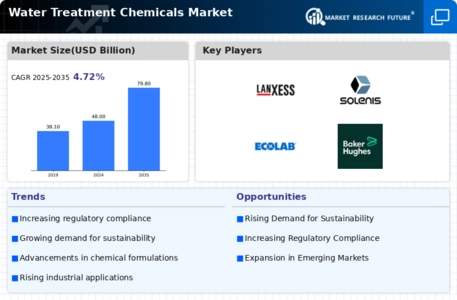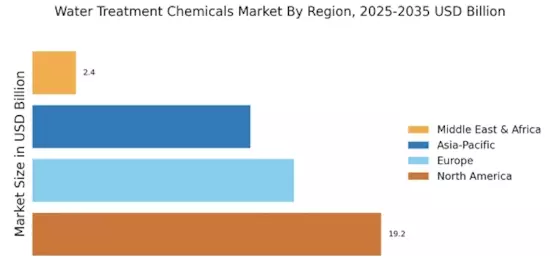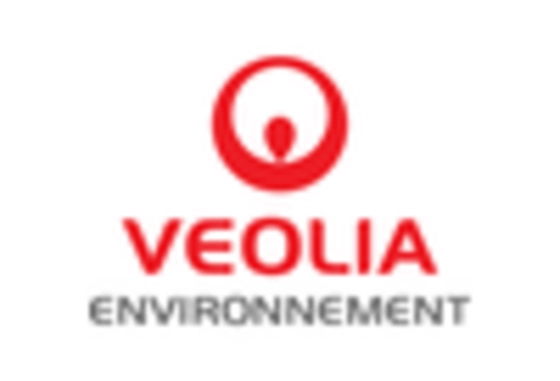Rising Water Scarcity
The increasing scarcity of freshwater resources is a critical driver for the Water Treatment Chemicals Market. As populations grow and industrial activities expand, the demand for clean water intensifies. This scarcity compels municipalities and industries to invest in advanced water treatment solutions, thereby boosting the market for treatment chemicals. According to recent estimates, the demand for water treatment chemicals is projected to grow at a compound annual growth rate of approximately 6% over the next few years. This trend indicates a robust market potential as entities seek to optimize water usage and ensure compliance with environmental standards. The urgency to address water scarcity issues is likely to propel innovations in chemical formulations, enhancing their effectiveness and efficiency in various applications.
Technological Innovations
Technological innovations play a significant role in shaping the Water Treatment Chemicals Market. Advances in chemical engineering and treatment processes have led to the development of more efficient and effective water treatment solutions. Innovations such as membrane filtration, advanced oxidation processes, and bioremediation techniques are transforming the landscape of water treatment. These technologies not only enhance the performance of treatment chemicals but also reduce environmental impact. The market is witnessing a shift towards eco-friendly and sustainable chemical solutions, driven by both consumer demand and regulatory pressures. As technology continues to evolve, it is expected that the Water Treatment Chemicals Market will experience a surge in new product offerings, catering to diverse applications across various sectors.
Health and Safety Regulations
Stringent health and safety regulations are a major driver for the Water Treatment Chemicals Market. Governments and regulatory bodies worldwide are implementing rigorous standards to ensure safe drinking water and protect public health. These regulations compel water treatment facilities and industries to utilize effective chemicals that meet safety and efficacy criteria. The market is likely to expand as compliance with these regulations becomes increasingly critical. For instance, the introduction of new guidelines regarding the permissible levels of contaminants in water has led to a surge in demand for advanced treatment chemicals. This regulatory landscape not only drives market growth but also encourages innovation in chemical formulations, as companies strive to develop products that align with evolving standards.
Growing Awareness of Water Quality
The growing awareness of water quality issues is a significant driver for the Water Treatment Chemicals Market. As consumers become more informed about the potential health risks associated with contaminated water, the demand for effective treatment solutions increases. This heightened awareness is prompting both residential and commercial entities to invest in water treatment systems that utilize specialized chemicals. Market data indicates that the residential segment is experiencing notable growth, as households seek to ensure the safety and quality of their drinking water. Additionally, businesses are increasingly recognizing the importance of water quality in maintaining operational efficiency and compliance with health standards. This trend is likely to sustain the demand for water treatment chemicals, as stakeholders prioritize the implementation of effective treatment solutions.
Industrial Growth and Urbanization
Rapid industrial growth and urbanization are pivotal factors influencing the Water Treatment Chemicals Market. As urban areas expand, the need for effective wastewater management becomes paramount. Industries such as manufacturing, pharmaceuticals, and food processing generate significant volumes of wastewater, necessitating the use of treatment chemicals to ensure compliance with environmental regulations. The market for water treatment chemicals is expected to witness substantial growth, driven by the increasing investments in infrastructure and the establishment of new industrial facilities. Reports suggest that the industrial segment accounts for a considerable share of the overall market, highlighting the interdependence between industrial activities and the demand for water treatment solutions. This trend underscores the importance of innovative chemical products that can address the specific needs of diverse industries.


















Leave a Comment